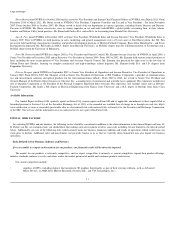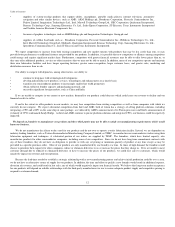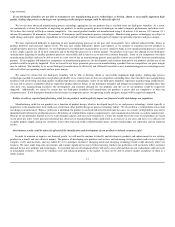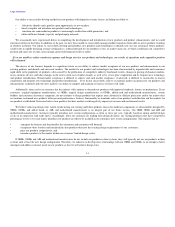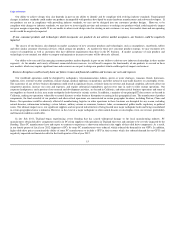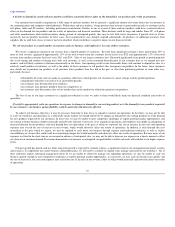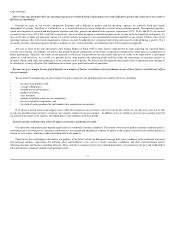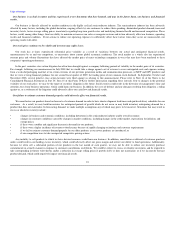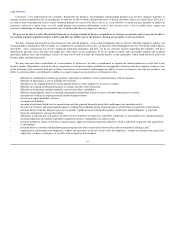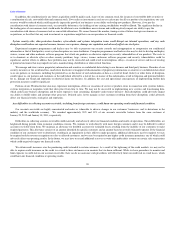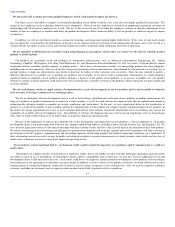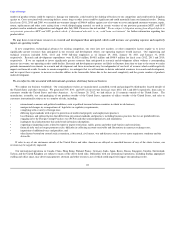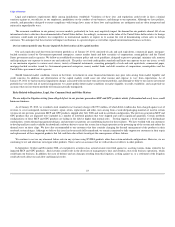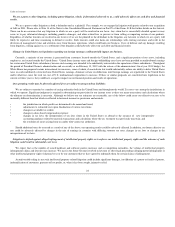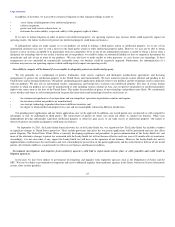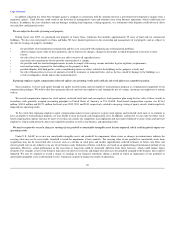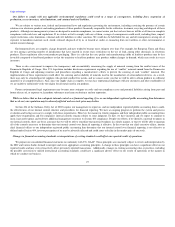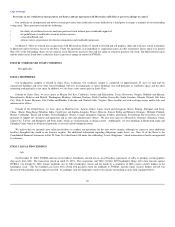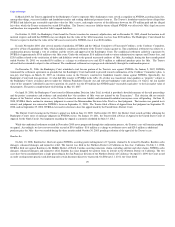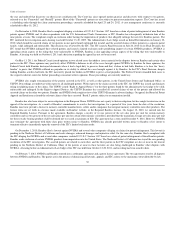NVIDIA 2012 Annual Report Download - page 22
Download and view the complete annual report
Please find page 22 of the 2012 NVIDIA annual report below. You can navigate through the pages in the report by either clicking on the pages listed below, or by using the keyword search tool below to find specific information within the annual report.
Table of Contents
We may not be able to attract and retain qualified employees which could negatively impact our business.
Our future success and ability to compete is substantially dependent on our ability to identify, hire, train and retain highly qualified key personnel. The
market for key employees in the technology industry can be competitive. None of our key employees is bound by an employment agreement, meaning our
relationships with all of our key employees are at will. The loss of the services of any of our other key employees without an adequate replacement or our
inability to hire new employees as needed could delay our product development efforts, harm our ability to sell our products or otherwise negatively impact
our business.
In addition, we rely on stock-based awards as a means for recruiting, motivating and retaining highly skilled talent. If the value of such stock awards
does not appreciate as measured by the performance of the price of our common stock or if our share-based compensation otherwise ceases to be viewed as a
valuable benefit, our ability to attract, retain, and motivate employees could be weakened, which could harm our results of operations.
We are dependent on third parties for assembly, testing and packaging of our products, which reduce our control over the delivery schedule, product
quantity or product quality.
Our products are assembled, tested and packaged by independent subcontractors, such as Advanced Semiconductor Engineering, Inc., Amkor
Technology, ChipPAC, JSI Logistics, Ltd., King Yuan Electronics Co. and Siliconware Precision Industries Co. Ltd. As a result, we do not directly control
our product delivery schedules, product quantity, or product quality. All of these subcontractors assemble, test and package products for other companies,
including some of our competitors. Since we do not have long-term agreements with our subcontractors, when demand for subcontractors to assemble, test or
package products is high, our subcontractors may decide to prioritize the orders of other customers over our orders. Since the time required to qualify a
different subcontractor to assemble, test or package our products can be lengthy, if we have to find a replacement subcontractor we could experience
significant delays in shipments of our products, product shortages, a decrease in the quality of our products, or an increase in product cost. Any product
shortages or quality assurance problems could increase the costs of manufacture, assembly or testing of our products, which could cause our gross margin and
revenue to decline.
We rely on third-party vendors to supply software development tools to us for the development of our new products and we may be unable to obtain the
tools necessary to develop or enhance new or existing products.
We rely on third-party software development tools to assist us in the design, simulation and verification of new products or product enhancements. To
bring new products or product enhancements to market in a timely manner, or at all, we need software development tools that are sophisticated enough or
technologically advanced enough to complete our design, simulations and verifications. In the past, we have experienced delays in the introduction of
products as a result of the inability of then available software development tools to fully simulate the complex features and functionalities of our products. In
the future, the design requirements necessary to meet consumer demands for more features and greater functionality from our products may exceed the
capabilities of available software development tools. Unavailability of software development tools may result in our missing design cycles or losing design
wins, either of which could result in a loss of market share or negatively impact our operating results.
Because of the importance of software development tools to the development and enhancement of our products, a critical component of our product
development efforts is our partnerships with leaders in the computer-aided design industry, including Cadence Design Systems, Inc. and Synopsys, Inc. We
have invested significant resources to develop relationships with these industry leaders and have often assisted them in the definition of their new products.
We believe that forming these relationships and utilizing next-generation development tools to design, simulate and verify our products will help us remain at
the forefront of the 3D graphics, communications and networking segments and develop products that utilize leading-edge technology on a rapid basis. If
these relationships are not successful, we may be unable to develop new products or product enhancements in a timely manner, which could result in a loss of
market share, a decrease in revenue or negatively impact our operating results.
If our products contain significant defects, our financial results could be negatively impacted, our reputation could be damaged and we could lose
market share.
Our products are complex and may contain defects or experience failures due to any number of issues in design, fabrication, packaging, materials and/or
use within a system. If any of our products or technologies contains a defect, compatibility issue or other error, we may have to invest additional research and
development efforts to find and correct the issue. Such efforts could divert our engineers' attention from the development of new products and technologies
and could increase our operating costs and reduce our gross margin. In addition, an error or defect in new products or releases or related software drivers after
commencement of commercial shipments could result in failure to achieve market acceptance or loss of design wins. Also, we may be required to reimburse
customers, including our customers' costs to repair or replace products in the field. A product recall or a significant
21


